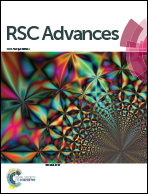Photo-enhanced hydrolysis of bis(4-nitrophenyl) phosphate using Cu(ii) bipyridine-capped plasmonic nanoparticles†
Abstract
We show that the hydrolysis of bis(4-nitrophenyl) phosphate by a Cu(II) bipyridine complex was enhanced by 1000-fold when covalently attached to 10 nm gold nanoparticles (AuNP) and irradiated with a 120 mW green laser at 532 nm when compared to an unsupported vinyl-substituted Cu bipyridine analog. The catalytic reaction was monitored by UV-vis spectroscopy in 20 mM MOPS buffer at pH 8 and at room temperature by observing the growth of the product, 4-nitrophenolate, at 405 nm. Initial rate data was analyzed using a Michaelis–Menten formalism. Control experiments suggested that the photo-enhanced hydrolysis reaction required that the Cu metal center be attached to the AuNPs via a thiolated bpy ligand. At higher laser power, the initial rate data deviated from the Michaelis–Menten formalism. Possible mechanisms are discussed.


 Please wait while we load your content...
Please wait while we load your content...